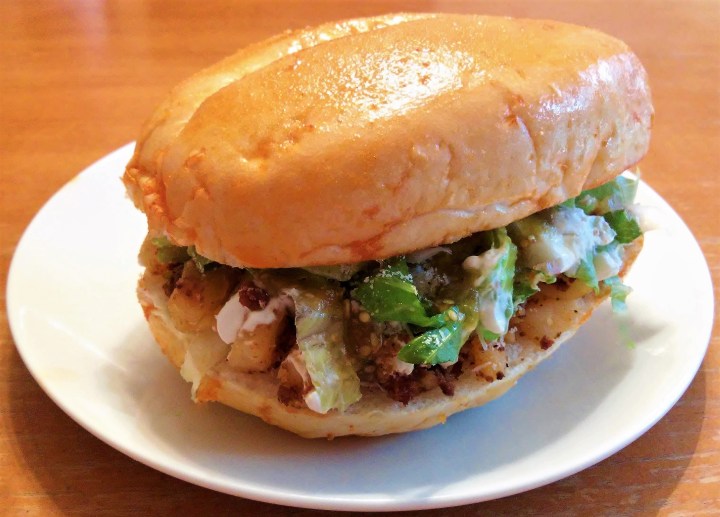
History Tidbit – September 15-16, 1810: The Cry for Independence
This weekend, Mexicans will be commemorating the onset of the Mexican Independence War. Right at midnight, on the night of September 15, 1810, Miguel Hidalgo y Costilla, a Roman Catholic priest in the town of Dolores, in the Mexican state of Guanajuato, rang the bell of his parish and called people to fight against the vice-regal European government. The insurgents began the war still supporting their Spanish king, who had been deposed by Napoleon back in Europe; over the course of the following eleven years, and after the death of many (including Hidalgo), the basic principle of fighting against a grubby and oppressive government remained, but it ultimately resulted in the birth of Mexico as an independent nation. This pivotal point in Mexico’s history is commemorated in many places around the country by re-enacting the dramatic call, named “El grito de Dolores” or “El grito de la Independencia” (“The Cry for Independence”). The town of Dolores was renamed Dolores Hidalgo, and the bell from its parish was brought to the National Palace in Mexico City, situated right in front of the main square (Zócalo). There, the president himself comes out to one of the balconies to re-enact “El grito”, finishing with the cry of “¡Viva México!”; the Bell of Dolores rings once again, resonating around the Plaza de la Constitución (“Constitution Square”), official name of the main square, completely filled with people gathered to participate in the ceremony. The celebration continues with activities to tease all the senses: music, light displays, fireworks, and of course, lots of food.
Antojitos (Little cravings) are prepared in the spot by street vendors: quesadillas, elotes, tamales, and many other delicious offerings. Tortas are probably the best known Mexican sandwiches, prepared with crusty buns called teleras, and filled with anything available to the cook’s imagination and resources: simple ingredients such as ham and cheese; regional delicacies, for example, octopus; and even tamales, known by some as the “double T” (tamales inside a telera!) There are, however, many other Mexican preparations involving bread; the star of the Independence celebrations is one of my personal favourites: pambazos. I have to be a little careful here, because it appears that several Mexican states claim their version to be “the real pambazo”, and the origin stories range from being a “pan basso” (“pan bajo”, “low bread”, for the lower classes during colonial times) to a fancy treat created for no less than emperor Maximilian I and his queen Charlotte, the eccentric rulers of Mexico during the French occupation (1864-67).
I am going to focus on the pambazos from my childhood in Mexico City. This is the sandwich I remember the most as a street food, omnipresent at nearby tourist attractions – especially outside convents and churches, for some unknown reason – and sold at every single outdoor event, including fairs, and religious or civic holidays. Probably the most attended outdoor event in Mexico City is “El grito”, and pambazos are perfect for this celebration because they feature Mexico’s flag colours, with a crispy red crust, and white and green ingredients inside. Pambazos sure bring back memories, and make me feel both patriotic and in a celebratory mood.
Pambazos
Printable recipes: Pambazos and Guajillo Adobo
Ingredients
4 pambazo buns (I used Portuguese buns; panini would be my next choice)
1/3 lb (150 g) Mexican chorizo
2 medium potatoes; peeled, cooked and cut into small cubes
Lettuce, chopped
Mexican cream (or sour cream mixed with a bit of milk)
Fresh cheese, crumbled (panela, or feta)
Salsa verde (cooked tomatillo sauce) check my recipe or bottled
Oil, for pan frying, if needed
Guajillo adobo, optional
Pambazo buns are oval shaped and flat, with a relatively soft crust, sometimes sprinkled with flour on top. It might be a challenge to find them even in Mexico, so if a substitution is needed, look for a soft and not too tall bun, such as panini. I found Portuguese buns, which are almost perfect, soft and dusted with flour on top, just slightly thicker than pambazos. I sliced the buns lengthwise in half, and set aside until ready to assemble:
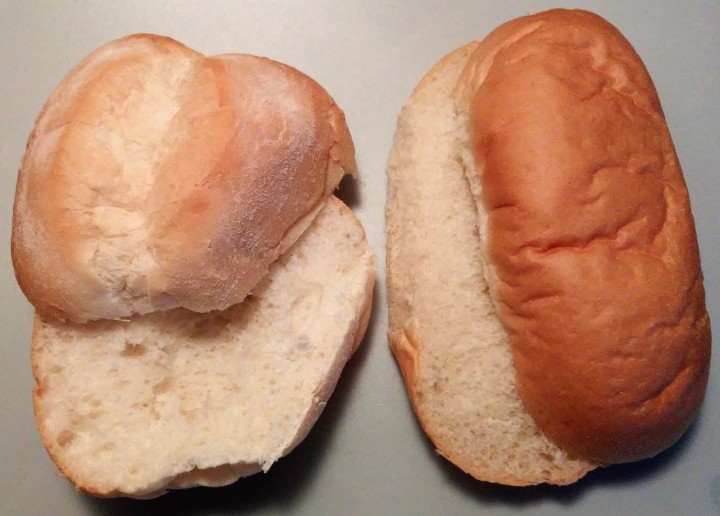
For the filling, I removed the case from the chorizo, and fried the meat in a pan, stirring and breaking into small pieces. When perfectly cooked, I drained and reserved the drippings (photo below, left), then mixed the potatoes in with the chorizo and continued cooking until the potatoes were slightly crispy and had turned red from the chorizo (right):
Before describing how I assembled my pambazos, I have to comment on the methods I reviewed on-line. For Mexico City style pambazos, all the recipes I found required the buns to be dipped in guajillo adobo, then pan fried with a generous amount of oil until the adobo dries out, and the buns become very crispy. Now, I am not sure if I have a distorted memory from my childhood, but I always thought that the red tint on pambazos came from coating the buns with chorizo drippings, which would then be the only fat needed to make them crisp while grilling on the pan. This method is less messy than using adobo, and the flavour is literally a perfect match for the chorizo and potato filling. Anyway, since I could not find a single source to corroborate my version, I decided to try both side to side and let an impartial judge (my husband) determine which would be the best technique for the tastiest pambazo.
I prepared a batch of adobo (directions in the printable recipe and at the end of this post). The outer sides of one bun were tapped on the reserved drippings from the chorizo (photo below, left), then I decided to brush adobo on another, instead of dipping, so it would not get too soggy. I placed them in a skillet over medium heat to crisp, adding just a bit of oil on the side with the bun brushed with adobo (photo right):
I then had to fill them with potatoes and chorizo; top with lettuce, cream, and cheese; and finish with green sauce. I was going back and forth around the kitchen and managed to burn (just a little) the pambazos! When I finally had them next to each other on a plate, they looked as stressed as I was feeling:
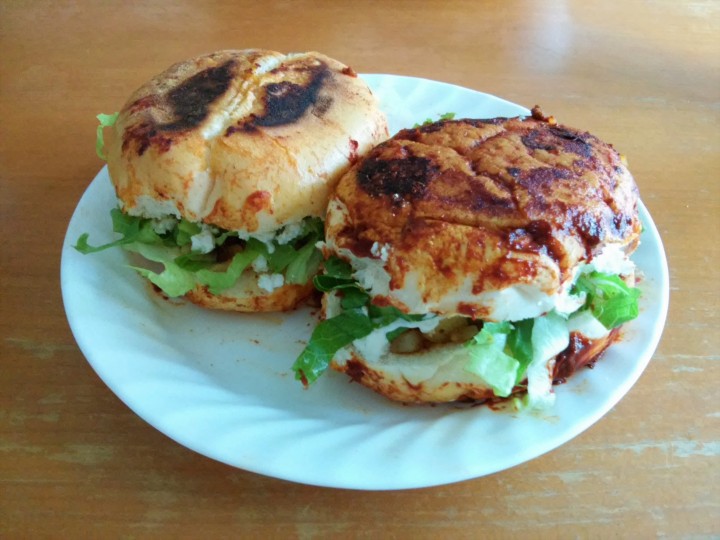
Nevertheless, the taste test proceeded; the charred spots were actually good, and without much deliberation, my husband chose my version! Ugly as they were, the pambazos were very tasty, and although I liked both, I seriously did not feel the taste of guajillo triggering any childhood memories of pambazos, unlike the bun coated with chorizo drippings, also with just the best crispiness, no comparison at all. The next batch of pambazos was prepared after cleaning and setting all the ingredients in an orderly manner (three words: mise en place); I also lowered the heat to medium-low for the skillet. The steps were very straightforward: coat outer sides of bun with reserved chorizo drippings, place bottom halves on hot skillet, coated side down; top with a generous portion of chorizo and potato filling, then lettuce, cream, cheese and green sauce. Close sandwich with the top slices, and carefully flip, to crisp the top halves. Flip back onto a plate, and serve hot, looking neatly Mexican: green sauce and lettuce; white cheese and cream; and red from the chorizo, both in the filling and coating the bun!

From the first bite, I felt transported to Mexico City, enjoying my pambazo on a cool September evening. It cannot be just me, there must be other people who remember pambazos coated with chorizo drippings, right? Anyone?
Anyway, I am going to enjoy the rest of my pambazo while watching this video of “El Grito”, featuring president Enrique Peña Nieto in Mexico City’s National Palace, along with a summary of the Mexican War of Independence.
¡Viva México!
Guajillo Adobo
Ingredients:
10 dry guajillo peppers
¼ medium onion, cut into large chunks
1 clove garlic, peeled
1 tsp salt, or to taste
Boiling water
Open one side of each pepper with a fork or paring knife; remove stem and seeds:
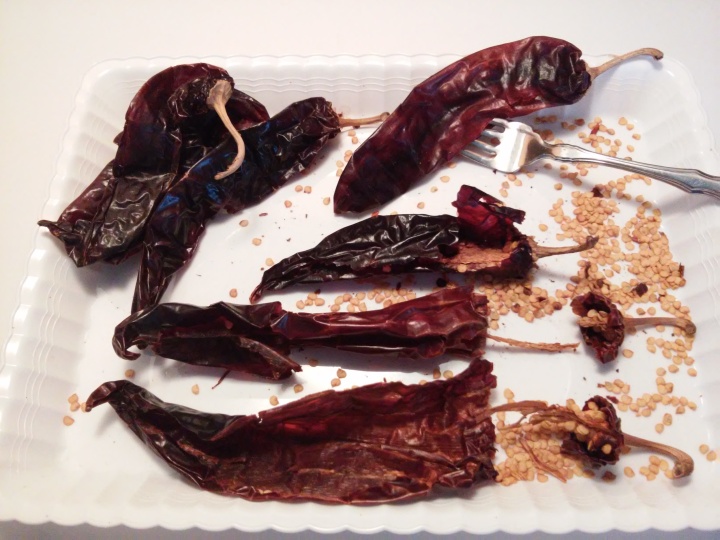
Place peppers in a bowl with boiling water, and let soak for 10 minutes: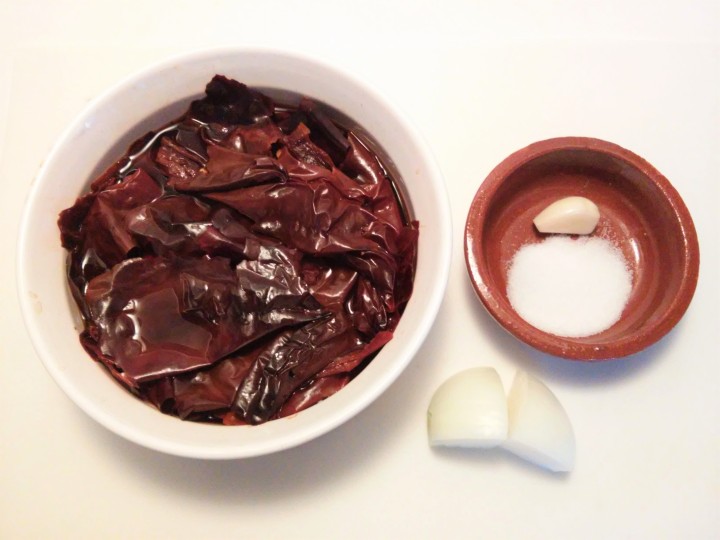
Process soaked peppers, onion, garlic, salt and one cup of the soaking water in the blender for about three minutes, until very smooth:

Use this adobo for brushing on pambazos; any leftovers may be fried in one tablespoon of vegetable oil or lard, and used as salsa for tacos or to add to stews and soups
Let’s party! I am joining Fiesta Friday #241 hosted by Angie @ Fiesta Friday, with co-hosts this week Zeba @ Food For The Soul and Debanita @ Canvassed Recipes




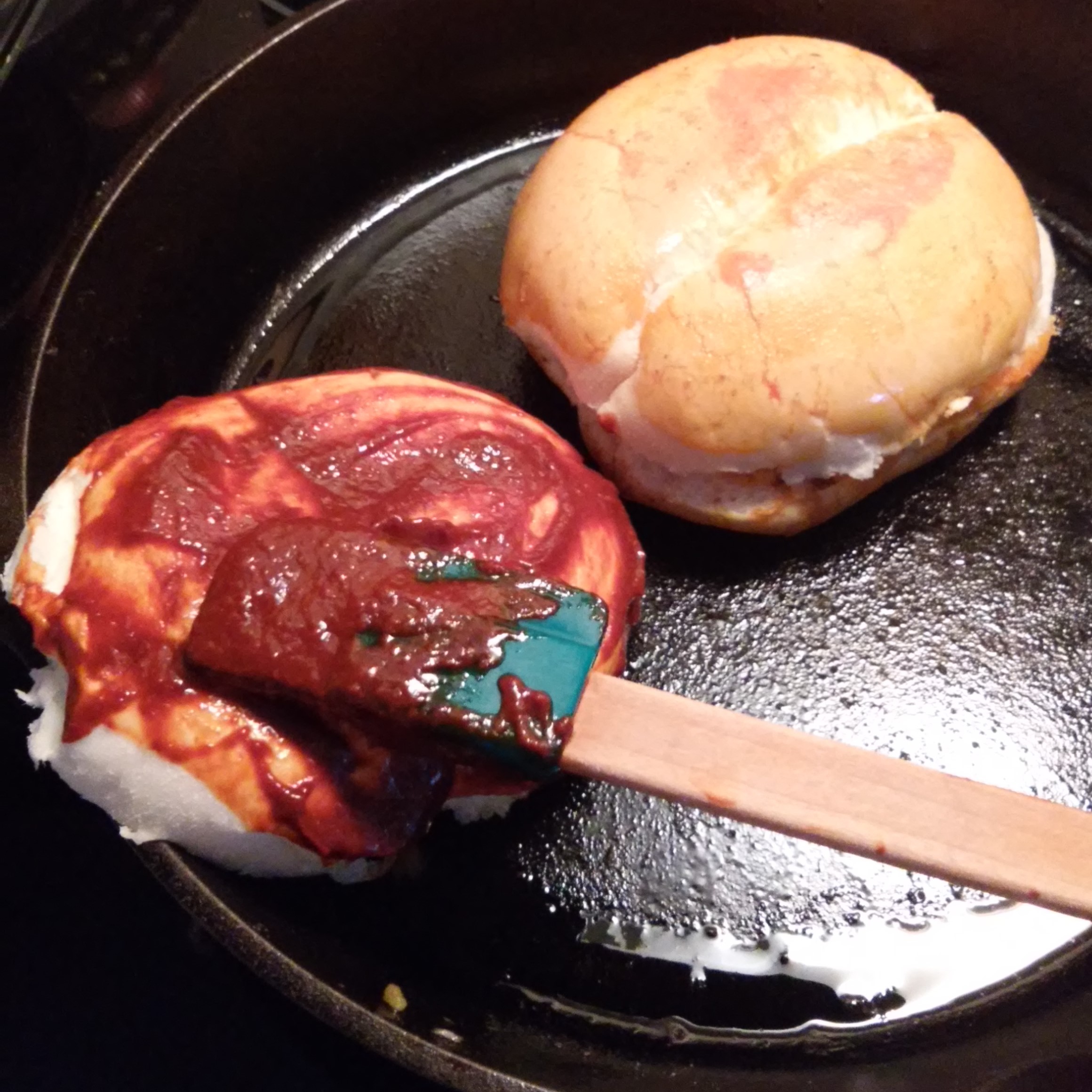







Can’t say I’ve ever had one of these sandwiches.
LikeLike
If you like chorizo, you must try them! (follow my recipe, it is so convenient, and we can start our own trend, hehe)
LikeLiked by 1 person
I do like chorizo!
LikeLiked by 1 person
Looks great. I was surprised potato was in the sandwich. I just assumed the bits of white i saw was onions. Didn’t realize there are cultural visual assumptions about what’s inside a sandwich so it’s cool to see a recipe with a sandwich I hadn’t ever seen in real life (or virtual life, for tht matter, lol). And thanks for the history lesson too.
LikeLiked by 1 person
Thank you for your feedback! I oftentimes learn from the comments, seeing things from a different perspective. 🙂
LikeLiked by 1 person
You are ambitious, my dear! I would probably buy the adobo sauce. I must admit I’ve never heard of pambazos, although I’ve lived in Mexico for 17 years. I will have to research that matter. Otherwise, I’m going to try making them myself. I’m not sure what buns to use as the lonches here are all made with bolillos..but I’ll ask my friend who has a restaurant. about this. Chorizo with potatoes sounds great, although is it possible they used grated cabbage instead of lettuce? That is what is used on any sandwich or taco here.
LikeLike
Yes, I imagine Jalisco would be into dipping in spicy sauce and using cabbage, each region is different. The buns are also called pambazos; they are flat and dusted with flour on top. Thank you for your feedback!
LikeLike
No Pambazos at the celebration I went to but oh, the food. Incredible buffet. I took photos.. will post later.
LikeLiked by 1 person
Oh yummy, looking forward to seeing your post!
LikeLike
I loved reading this post and all that history makes this so special. Thanks for sharing on Fiesta Friday!
LikeLike
Thank you so much, Zeba!
LikeLiked by 1 person
I can’t remember if I’ve had pambazos but they do sound delicious. How can you ever go wrong when you start with chorizo. I’ve been thinking of making my own, chorizo that is. Can’t be all that difficult, can it? Of course knowing me I would bungle it somehow 😀
LikeLike
Hi, Angie! Chorizo is definitely a winning starting point. My mom used to make her own fresh chorizo, Northern Mexico style; the key for that style is to have ancho peppers and a good amount of cumin. Commercial chorizo tends to be flavoured more in Central Mexico style, which I think also has pasilla peppers, and is cured. Maybe I should also try to make my own, and we could compare notes 🙂
LikeLike
Lovely share! Thanks for sharing this at Fiesta Friday!
LikeLiked by 1 person
thank you, Debanita!
LikeLike
The flavors in your pambazos recipe sound amazing! Thank you for sharing this delicious recipe!
LikeLike
Thank you so much, Becky!
LikeLike
My mouth is watering at the thought of these! I make my own chorizo. Not sure how authentic it is but I had to because I didn’t used to be able to get chorizo! But it’s not the kind in casings so I’m sure it’s different! Still, I might see what kind of rolls I can find so I can at least make an approximation of this lovely sandwich!
LikeLike
Hi, Mollie! Angie @ Fiesta Friday commented that she is thinking of making chorizo (see previous comments), and I mentioned that my mom used to make her own, fresh chorizo (no casing, like yours). I hope you try the pambazos!
LikeLiked by 1 person